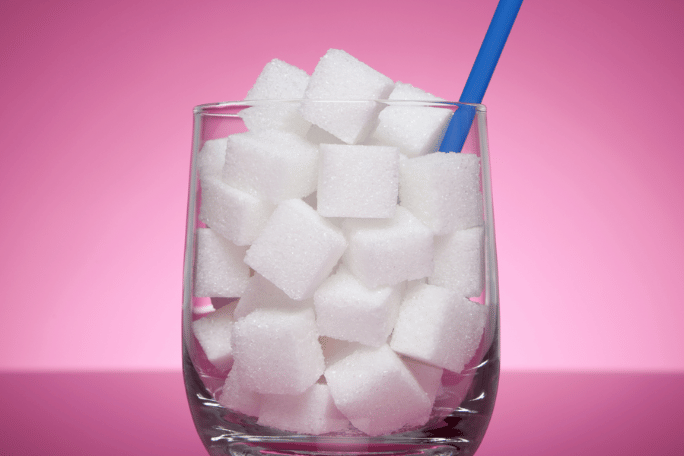Lesson summary
The World Health Organisation recommends a healthy diet containing only six teaspoons of sugar per day. Yet on average Australians consume 14-16 teaspoons of sugar per day!
Of course, no one’s taking a teaspoon to a packet and eating those granules raw (at least we hope not!), so where is all that sugar hiding?
This lesson helps young students visualise how much sugar they’re consuming, and reveals just how much sugar can hide by dissolving in a single glass of water.
Learning intentions:
Students will...
- understand how foods and drink contain a lot of hidden sugar
- understand the large quantity of sugar in our daily intake
- understand how to find and interpret nutrition labels on food packaging
Success criteria:
Students can...
- make a connection between grams of sugar and the equivalent amount of teaspoons of sugar
- visually represent the amount of sugar in a variety of foods
- conduct an experiment to find how much sugar can dissolve in a glass of water
- find sugar amounts on food packaging labels
Lesson guides and printables
Lesson details
Curriculum mapping
Learning Outcome 3: Children have a strong sense of wellbeing
3.2 Children take increasing responsibility for their own health and physical wellbeing
Learning Outcome 4: Children are confident and involved learners
4.1 Children develop dispositions for learning such as curiosity, cooperation, confidence, creativity, commitment, enthusiasm, persistence, imagination and reflexivity
Learning Outcome 5: Children are effective communicators
5.1 Children interact verbally and non-verbally with others for a range of purposes
5.2 Children engage with a range of texts and gain meaning from these texts
5.3 Children express ideas and make meaning using a range of media
This lesson is part of the wider unit of work SugarByHalf – Guardians of the Gums – Early Learning to Year 2
Time required: 45 mins
Level of teacher scaffolding: High – conduct the experiment and facilitate understanding of high level concepts
Resources required
- Device capable of presenting a video to the class
- Kitchen scales
- Packet of sugar (or substitute with sand)
- Plates x 3
- Teaspoon or teaspoon measurement
- The Sneaky Sugar Cube story – you can read the book yourself or watch a video of it being read here.
- Various food packaging such as:
- Bottle of fruit juice
- Cake box
- Can of soft drink
- Chocolate bar wrapper
- Any other alternatives you have on hand
Additional info
These lessons were developed in partnership with SugarByHalf and the Australian Dental Association. Guardians of the Gums was written by Bee Healthy Stories; if you would like to see more of their stories, head to Bee Healthy Stories.
SugarByHalf promotes action to reduce sugar-related diseases so that we can live better, stronger and healthier lives.
Their message is simple: to reduce added sugar consumption by half. Eating too much added sugar is a key driver of serious health problems including obesity, type 2 diabetes, heart disease, tooth decay, dementia and mental health conditions. A poor diet also puts children behind their peers, affecting brain development, sleep and ability to learn. Poor diet choices ultimately mean that this generation of children could be the first in modern history to live shorter lives than their parents.
Much of the added sugar in our diet comes from the processed foods and drinks we consume. On average, we consume 14-16 teaspoons of added sugar per day. Teenagers consume more than 20 teaspoons per day. The World Health Organisation says we should limit our daily added sugar intake to 6 teaspoons for good health. To put that in perspective, there are 4 grams of sugar in one teaspoon. If something has 20 grams of sugar, that's 5 teaspoons of sugar.
This English lesson focuses on developing the skills and knowledge students need to critically consider messages about food and drink they are exposed to, thereby equipping them to be able to make healthy choices.
Talking about Health:
- Be mindful of students who may experience weight stigma. Some students may be sensitive to conversations around weight, body size or shape. Terms including obesity, weight issues, weight-problem and fat can be stigmatising for some people because they assign blame. It is important to note individual preferences around language vary. Research has shown using the terms ‘weight’, ‘weight gain’, ‘healthy weight’, ‘unhealthy weight’, and ‘high BMI’ are preferred as better alternatives.
- Be mindful about how you use the word ‘diet’. We recommend focussing students on the positive impacts of healthy nutrition and healthy lifestyles which help us to have stronger bodies and minds, feel good and sleep well.
- Steer students away from any focus on appearances by communicating that appearance does not determine your worth. We recommend the fact sheets from the Butterfly Foundation on body image tips.
- Avoid using labels such as obese or diabetic. Refer to people living with diabetes, people living with cancer, people with high BMI etc.


Welcome back!
Don't have an account yet?
Log in with:
By signing up to Cool.org you consent and agree to Cool's privacy policy to
store, manage and process your personal information. To read more, please see
our privacy policy here(Opens in new tab).
Create your free Cool.org account.
Many of our resources are free, with an option to upgrade to Cool+ for premium content.
Already have an account?
Sign up with:
By signing up to Cool.org you consent and agree to Cool's privacy policy to
store, manage and process your personal information. To read more, please see
our privacy policy here(Opens in new tab).